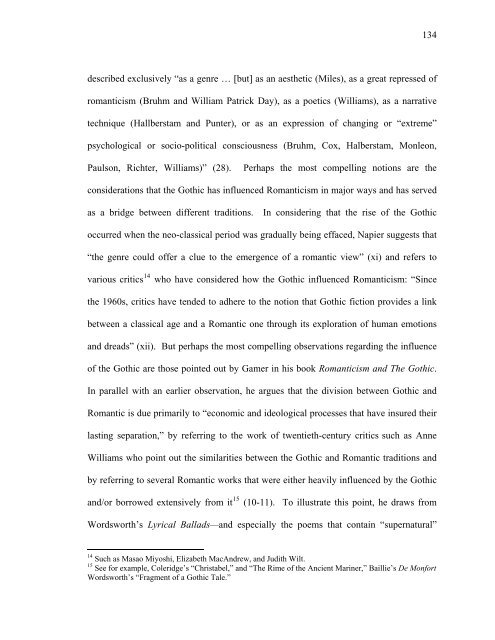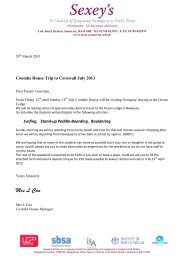Untitled - Sexey's School Moodle
Untitled - Sexey's School Moodle
Untitled - Sexey's School Moodle
Create successful ePaper yourself
Turn your PDF publications into a flip-book with our unique Google optimized e-Paper software.
described exclusively “as a genre … [but] as an aesthetic (Miles), as a great repressed of<br />
romanticism (Bruhm and William Patrick Day), as a poetics (Williams), as a narrative<br />
technique (Hallberstam and Punter), or as an expression of changing or “extreme”<br />
psychological or socio-political consciousness (Bruhm, Cox, Halberstam, Monleon,<br />
Paulson, Richter, Williams)” (28). Perhaps the most compelling notions are the<br />
considerations that the Gothic has influenced Romanticism in major ways and has served<br />
as a bridge between different traditions. In considering that the rise of the Gothic<br />
occurred when the neo-classical period was gradually being effaced, Napier suggests that<br />
“the genre could offer a clue to the emergence of a romantic view” (xi) and refers to<br />
various critics 14 who have considered how the Gothic influenced Romanticism: “Since<br />
the 1960s, critics have tended to adhere to the notion that Gothic fiction provides a link<br />
between a classical age and a Romantic one through its exploration of human emotions<br />
and dreads” (xii). But perhaps the most compelling observations regarding the influence<br />
of the Gothic are those pointed out by Gamer in his book Romanticism and The Gothic.<br />
In parallel with an earlier observation, he argues that the division between Gothic and<br />
Romantic is due primarily to “economic and ideological processes that have insured their<br />
lasting separation,” by referring to the work of twentieth-century critics such as Anne<br />
Williams who point out the similarities between the Gothic and Romantic traditions and<br />
by referring to several Romantic works that were either heavily influenced by the Gothic<br />
and/or borrowed extensively from it 15 (10-11). To illustrate this point, he draws from<br />
Wordsworth’s Lyrical Ballads—and especially the poems that contain “supernatural”<br />
14 Such as Masao Miyoshi, Elizabeth MacAndrew, and Judith Wilt.<br />
15 See for example, Coleridge’s “Christabel,” and “The Rime of the Ancient Mariner,” Baillie’s De Monfort<br />
Wordsworth’s “Fragment of a Gothic Tale.”<br />
134



